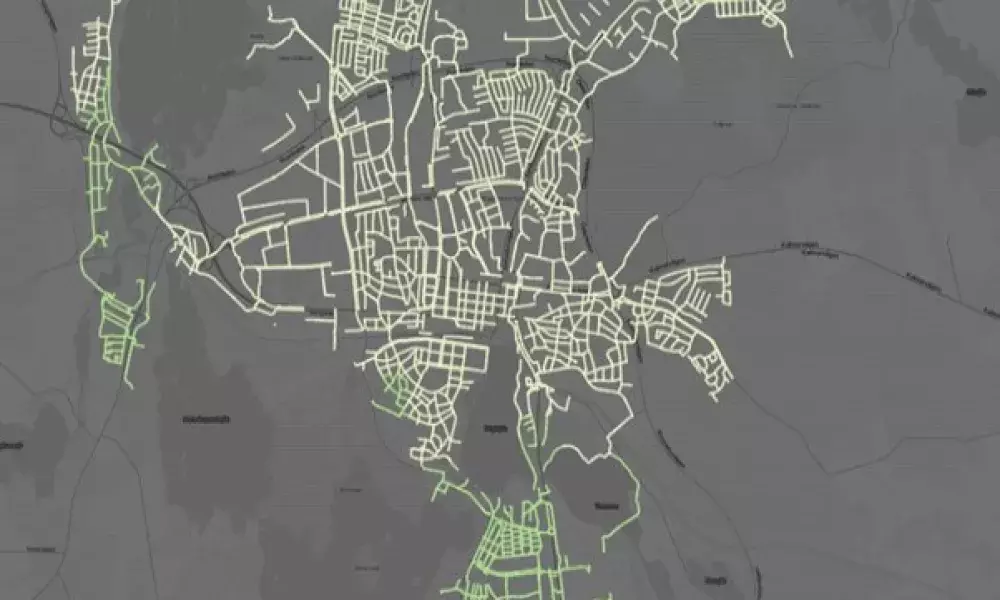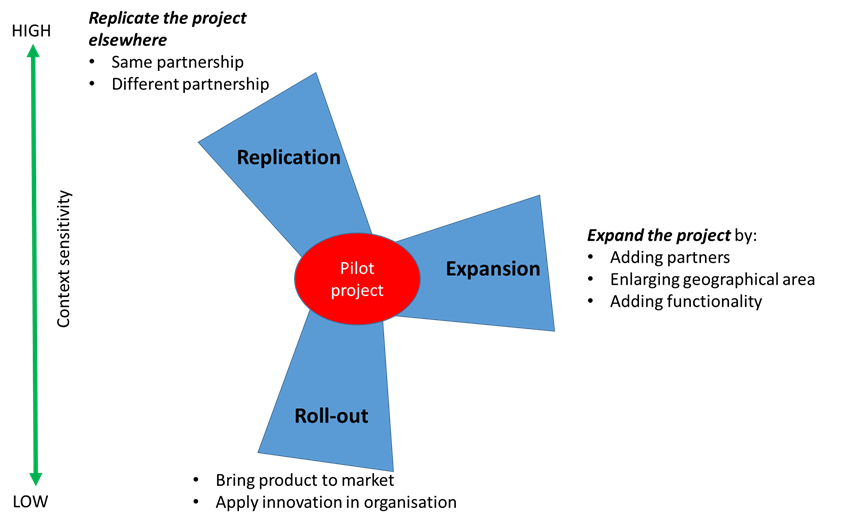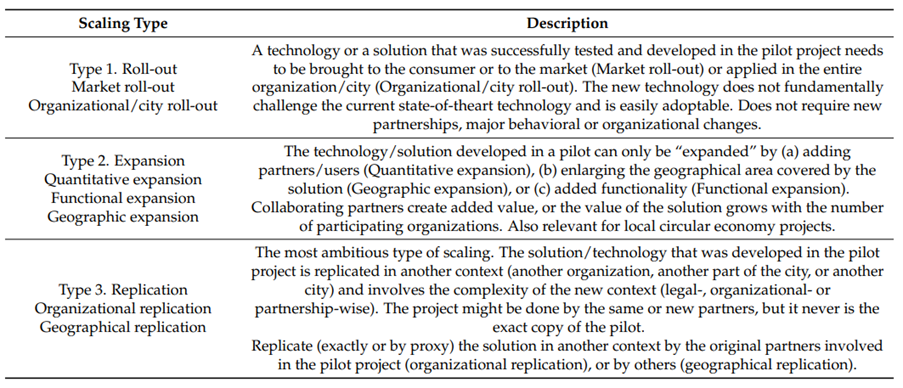
People and organizations everywhere are working to make the city more sustainable, more circular and climate-proof. Sustainable innovations cannot be bought, we have to make them ourselves by trial and error to find out whether a new approach works or not. It's not just about deploying new technology – although it often starts with that. There are organizational, financial, legal and behavioural aspects to every smart city project, and they must be dealt with simultaneously.
In order to move forward, cities all over the world have embraced experimentation: the city can be seen as a living laboratory where new techniques and concepts are tested in the field of mobility, sustainable energy, sustainable construction, logistics, and so on. Experiments and new approaches are supported and encouraged by innovation subsidies, among others from Urban Innovative Actions. But what happens when the experiment ends? How can successful experiments be turned into permanent innovations and adopted on a larger scale?
In this zoom-in, we will focus on the challenge of upscaling, with illustrative examples from the DIACCESS project. In that project, the Swedish city of Växjö is developing a range of smart city innovations, and it has developed a vision on how these innovations can be scaled up. Three innovations are now entering the upscaling stage: smart waste collection, smart heating in schools, and smart snow clearing methods. Each innovation is developed in partnership between a city department and a private company, and faces particular issues regarding upscaling. The companies involved in each innovation were selected through an innovative procurement process named innovation partnership: this allows the city to co-develop the solution with the private supplier, rather than buying the innovation of-the shelf.
This zoom in is organised as followed. First, we introduce a distinction between three types of scaling: roll-out, expansion, and replication, and we will explain how these types of scaling are currently playing out in the DIACCESS project. Next, we analyse how Växjö has avoided some of the very typical problems of scaling that occur so often in urban innovation projects. We will see how the innovation partnership model in adopted in Växjö has built in some safeguards to prevent the scaling process from stalling.
Within the DIACCESS project, Växjö works on the following three innovations:
Smart heating: With company WINNIIO AB, Växjö Municipality is creating AI-driven self-learning buildings, focusing on Smart Heating Systems. The new solution is set up to optimize the flow of energy down to each radiator, ensuring an efficient heating distribution and reducing CO2 emissions for buildings. It is tested in a few primary schools in Växjö.
Smart waste collection: Data driven logistics will enable a new way of pick-up of household waste in Växjö. 1400 waste bins are equipped with sensors, meaning that 25% of the apartment buildings have tested a digitized method for emptying, based on artificial intelligence. Växjö works with the company Bintel, who together with SSAM (Växjö municipality's waste and environmental company) developed the new solution during an innovation partnership.
Smart snow clearing: Växjö municipality has entered an innovation partnership with the company Klimator, with the goals to combine research and smart technology, as basis for a digitized decision-making system for how Växjö's road and cycle paths are to be cleared of snow and combat slipperiness. The system is currently being tested in practice.
The EU invests substantially in all sorts of urban experiments and pilot projects (through subsidies, grants or loans) and puts high value on the upscaling of good practices. Typically, to obtain EU funding, projects must a priori show that they have scaling potential, or even have explicit scaling strategies built in the project plans. But upscaling is a complex topic, fraught with ambiguities and difficulties.
The word “upscaling” is meant very often in the context of urban innovations, but it can mean many things. Three types of scaling can be discerned (see figure 1 and table 1): Roll-out, expansion, and replication[1]. All of them take place in the DIACCESS project, as we will see below.
Figure 1 Types of scaling

Table 1 Explanation

Roll-out
A first type of upscaling is roll-out. In this scenario, a newly developed innovation can be produced on a larger scale, sold on the market to other clients, or broadly adopted in the organisation. Roll-out is a relatively simple form of scaling in the sense that the decision to scale-up can be taken by a single organisation. For example, a city can do an experiment to co-develop new smart lampposts, together with a lamppost producer. When the pilot is successful, the lamppost producer can scale up the production and sell the posts to many other cities. And the city can decide to put the lampposts everywhere in the city.
The roll-out type of upscaling is happening in Växjö as well. In the DIACCESS project, the city of Växjö actively advocates the roll-out of new innovations by the companies it works with. The city invited private companies to co-develop specific smart city solutions. Contractually, it was arranged that the intellectual property (IP) of these solutions goes to the companies. That means that once the company has developed a new successful product or service, it can also “sell” it to other cities, and hence upscaling will occur. For example, the city worked with a private company, Bintel, to create a solution for more efficient waste collection. Bintel developed smart sensors that can be installed in waste bins, that indicate how full the bins are. The company owns the IP, and is free to sell these sensors also to other waste companies as it deems good. Note that this type of scaling works well for products that can be sold relatively stand-alone (such as the bins sensors in our example); As we will see later it is much harder to scale up complex services for which adaptation and coordination with the client is needed. A similar story goes for the smart school heating innovation; here, Växjö works with a small number of local schools to lower energy use at schools using smart sensors. The partner company can sell the sensor configuration to other schools, or any building owner who might be interested.
Expansion
A second manifestation of scaling is expansion. In this scenario, an urban innovation is first piloted in a small area or with a small number of partners, and then, after successful testing, is applied in a larger area of the city. A typical example is a logistic hub: A city might start a small-scale pilot to develop a smart logistic hub at the edge of the city, to reduce freight traffic in the city centre. This is a complex innovation because you need to work with more partners (logistics providers, various city departments, clients). Then, when the pilot is successful, the city can expand the project by adding more hubs, and increase the number of logistic providers that participate. Note that this type of scaling takes more effort and needs much more coordination, it is not a matter of simple “roll out” or “mass produce”.
In the DIACCESS project, this type of scaling is happening in all three innovations that Växjö is currently developing. In one project, the city’s waste company selected the private firm Bintel to co-create a smart waste collecting system in which sensors in waste bins signal when the bins must be emptied. This innovation makes the waste collection more efficient (saving money for the city and reducing the ecological footprint) and also better (avoiding overloaded bins on the streets or in housing estates). The pilot test area is relatively small, involving 238 property owners and 7,894 residents in the north of Växjö. But when successful, the waste company wants to scale it up in the sense that the system will be applied to other parts of Växjö as well. Here, scaling up means the expansion of the area in which the innovation is applied. This type of scaling is still not too complex because takes place in the same city, and it’s done by the same partners.
Replication
The third type of scaling is more difficult: replication. Here, a complex urban innovation (such as the logistics hub described before) is replicated in another city. In the case of Växjö, we see that other cities became interested to replicate Växjö’s smart city innovations. During the Swedish innovation week in 2021, Växjö presented their recent innovations -including the ones developed in the DIACCESS project); several other Swedish cities showed interest to “replicate” the snow clearing solution that was showcased. Note that this “replication” type of scaling is nothing like scaling up a production line: each city has its specific local context (climate conditions, but also the way snow clearing is currently organised, how the municipal departments are structured etc), so there will never be a 1-on-1 copy of the Växjö solution, much adaptation will be needed, and also the users of the technology (the drivers or the snow clearing vehicles, and the planners who makes the routes) must be involved to have the same approach applied in another city. Thus, for each new client, the private company Klimator will always have to work with city departments that have current systems in place, and staff that is used to do things in a certain way. Hence, there will always be a lot of deliberation to adapt the solution to specific demands of the city department and the users of the system.
Table 2 shows the three types of upscaling, for the three innovations that are being developed in Växjö.
Table 2 Upscaling of the three innovations
|
|
Smart snow cleaning |
Smart heating |
Smart waste collection |
|
Roll-out |
KLIMATOR sells its new ICT solution to other clients |
WINNIIO AB sells its configuration of sensors, components and AI to other building owners |
Bintel sells its sensors + software to other clients |
|
Expansion |
The smart snow cleaning pilot is expanded to the whole city of Växjö |
The smart heating pilot is expanded from 4 schools to all schools of Växjö |
The pilot area is expanded from one neighbourhood to the entire city |
|
Replication |
The smart snow cleaning system is replicated in other cities |
Other cities adopt the same smart heating solution as the one developed in Växjö |
Other cities also adopt this system of smart waste collection |
|
|
|
|
|
[1] van Winden, W., & van den Buuse, D. (2017). Smart city pilot projects: Exploring the dimensions and conditions of scaling up. Journal of Urban Technology, 24(4), 51-72.
It is a well-known problem in the smart cities domain that upscaling is difficult, and often does not happen at all. As such, it is quite natural that not every pilot or experiment will scale up. Experimental pilot projects can fail, and that's okay because you learn from them, and the knowledge acquired can be used in a subsequent project. But too often, successful pilots are not continued either, so that their impact remains very limited. From that perspective, it is remarkable how well the innovations in Växjö are scaling up so far. In this section we explore potential barriers that often hinder upscaling, and then highlight how Växjö has managed to overcome these barriers so far.
No more funding after the experiment
An important cause of failed scaling of smart city projects is that all the money and attention goes to the experiment, and too little – or not at all – is thought about the scaling phase. At the end of the pilot, the money has run out and there are no structural resources for scaling up. Then it is often easier to just look for the next subsidy to try something new.
In the DIACCESS project, this risk is mitigated because the funding for the innovation pilots, unlike in many other cases, is not restricted to the experimentation phase. Rather, the innovation trajectories are set up in such a way that the experiments are only started when there is a reasonable chance that they will lead to an innovation so useful that it will be implemented by the city. The innovation partners are selected after a thorough dialogue with them on how to proceed during and after the experimentation phase.
“Not invented here…”
A further common threat to upscaling is the “not invented here” syndrome: the innovation team believes in the new approach, but for upscaling other people and parties also have to participate. And they also see disadvantages, threats, risks, or think they know that other solutions are better. Scaling up also becomes difficult if the experiment/pilot project is not really supported by the decision-makers in the organization; managers are usually enthusiastic about pilots because they are low-cost, generate positive publicity, and in any case give the impression that the organization is innovating. But when the pilot is successful and the time for implementation has arrived, they often step on the brakes because the consequences are far-reaching. In the case of DIACCESS, this barrier is overcome because city leadership is firmly behind the development of the pilots, and explicitly wants them to scale up. Moreover, because the smart city projects in Växjö are developed as part of a procurement process, there are serious budgets available for the post-experiment scale-up stage.
Experiment versus day-to-day business
Scaling up can also be difficult if the innovation team, no matter how skilled and innovative, is way ahead of the game, and too far removed from day-to-day operations. In that case, the resistance to upscaling is actually already built into the experimentation phase; operational departments, which have to keep things running, don't like to introduce the new approach, especially if major adjustments are necessary. The trick is therefore to find a good balance between exploration (discovering new things, innovating), and exploitation (performing daily operational tasks). It is therefore important to involve the operational departments in pilot projects from the outset. But a disadvantage can be that more radical experiments then will not be started. In DIACCESS, this barrier is mitigated because there is basically no difference between the innovation team and the implementation team. The staff of the city departments that work on the pilot are the same people who oversee the implementation of the innovation at a later stage.
Different interests in the consortium
Sometimes scaling up does not get off the ground because parties in the consortium work very closely together on the pilot – certainly if a subsidy can be allocated –, but when push comes to shove, they still have very different interests in scaling up and implementation. In DIACCESS, the project partners may indeed have different views on scaling, but they are not contradictory. For the private companies involved in the DIACCESS pilots, scaling-up means roll-out: increasing their market, selling their product also to other clients. For the Växjö city departments, scaling means expansion: making sure the innovation will move from a small pilot area to the whole city. Their different views are clear and explicit and do not work against each other.
Support and engagement of citizens and end-users
A large barrier to innovation scale-up is the absence of citizens/user engagement in the pilot stage. If a pilot is set up in a technocratic manner, the results might be a technically working prototype that nobody wants to use. Hence, deep and thorough user involvement from the beginning is key. In Växjö, this is done in each of the three smart city innovations: the teachers and headmasters are involved in the school heating; the drivers and planner are engaged in the snow cleaning; and the drivers and planner of the waste company are involved in the smart waste collection pilot.
From the experiences of the DIACCESS project so far, we can derive 5 tips for scaling up that might be relevant for any city that engages in smart city experimentation:
- When designing an experiment or pilot, think carefully about scaling up after the pilot phase. The innovation partnership method as applied in Växjö is a good tool for that.
- Make sure that the innovation team does not only consist of (technical) enthusiasts; also involve citizens, users and operational departments that will have to deal with it.
- Regularly put the theme of scaling up in the innovation team; often it turns out that team members have very different views and that is bound to lead to problems later on
- Ensure that decision-makers in the organization(s) remain involved, informed and involved in the pilot project
- Be explicit about the ownership rights of any successful innovation as soon as possible
About this resource
The Urban Innovative Actions (UIA) is a European Union initiative that provided funding to urban areas across Europe to test new and unproven solutions to urban challenges. The initiative had a total ERDF budget of €372 million for 2014-2020.
Similar content




